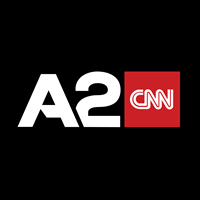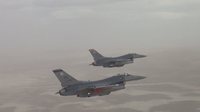In the background of the war between Israel and Hamas, another dangerous clash is coming to life, that between militias supported by Iran and US forces in Syria and Iraq. The Biden administration has responded to attacks on its forces with 3 aerial bombing campaigns against Iranian bases.
But what is the history and what are the risks of such an escalation. Our colleague Rosalba Bejdo explains this to us.
1- The United States has entered an escalating spiral of attacks and counterattacks with Iranian-backed groups in the Middle East. The spiral was provoked by the war between Israel and Hamas, and began on October 17, with attacks involving drones and indirect fire against US forces in Iraq and Syria... Iran-backed groups based in Iraq appear to be the only ones claiming responsibility for these attacks are being carried out amid the expansion of US military assets in the region...
2-The Pentagon reports at least 52 attacks on bases in Syria and Iraq in less than 4 months, where about 56 American soldiers were injured. The United States has retaliated with 3 waves of attacks against positions linked to Iran's Revolutionary Guard and other support groups in several weeks. Weapons depots, training centers and safe havens in Syria and Iraq have been targeted.
3-Yes Who are the groups that attack the USA?
An umbrella entity calling itself the Islamic Resistance has claimed responsibility for most of the attacks on US forces in Iraq and Syria. It mainly includes Iraqi groups linked to the 'axis of resistance', as Iran's network of allied states such as Syria is known, and non-state actors including the Houthi rebels in Yemen, Hezbollah in Lebanon and Palestinian groups such as Hamas. and Islamic Jihad. The main Iraqi groups in this coalition include Kata'ib Hizbollah, Harakat al-Nujaba, Kata'ib Sayed al-Shuhada, and the Badr organization.
4-Por cili është historiku i armiqësisë mes SHBA dhe milicive pro Iranit ne Irak? Marrëdhënia e tensionuar, por pa e kaluar vijën e kuqe, mes shteteve të bashkuara me milicivë te mbështetura nga Irani në Irak, shpërtheu në vitin 2018 pas vendimit të njëanshëm të presidentit Donald Trump për tu tërhequr nga marrëveshja bërthamore e Iranit e vitit 2015. Fërkimet filluan pas rikthimit të sanksioneve ndaj Iranit, si pjesë e fushatës së ‘presionit maksimal’ të Donald Trump dhe vendimit të tij për ta shpallur gardën revolucionare të Iranit si organizatë terroriste. Një sulm raketor në dhjetor të 2019-tës, vrau një kontraktor civil amerikan dhe plagosi 4 të tjerë. Luftimet krijuan terrenin për sulmin ajror amerikan në 2 janar të 2020-tës, që vrau gjeneralin Kasem suleimani , kreu I forcave elitë Quds dhe Abu Mahdi al-Muhandis, themelues dhe komandant I Kata’ib Hizbollah. Teherani u kundërpërgjigj me një breshëri sulmesh raketore ndaj forcave amerikane në Irak, duke lënduar mbi 100 ushtarë.
5-Edhe armiqësitë mes SHBA dhe grupeve të mbështetura nga Irani në Siri përshkallëzuan gjatë administratës Trump me shumicën e luftimeve të përqëndruara rreth bazës ushtarake të Al-Tanf. Një prej periudhave më të acaruara ishte në maj dhe qershor të 2017-tës, kur ushtria amerikane u përplas me luftëtarët qe mbështesnin qeverinë siriane, duke ndërmarrë sulme ajrore dhe duke rrëzuar dy dronë. Megjithatë nuk është e qartë se çfarë saktësisht synonin të përmbushin trupat amerikane në Al-Tanf.. Përplasjet vijuan edhe pas largimit të Trump nga pushteti, me administratën Biden që ndërmori një sërë sulmesh ajrore kundër grupeve të paspecifikuara të mbështetura nga Irani në Siri.
6-Po pse shpërtheu tani armiqësia? Intensifikimi I sulmeve mes forcave amerikane dhe milicive të mbështetura nga Irani në tetor të 2023 I dha fund një periudhe relativisht te qetë mes Uashingtonit dhe Teheranit. Zbutja informale e tensioneve ishte pjesë e negociatave indirekte në Oman por gjithçka ndryshoi me shpejtësi në muajin tetor. Një javë pasi Izraeli nisi fushatën ushtarake në Gaza, grupet e mbështetura nga Irani nisën sulmet ndaj bazave amerikane në Siri dhe Irak. Ripërtëritja e sulmeve, të kombinuara me shënjestrimet e pretenduara, apo konfirmuara ndaj izraelit nga grupet në Liban, Siri, Irak dhe Jemen, sugjeron një përpjekje të “aksit të rezistencës” për ti bërë presion Izraelit të zbusë operacionin në Gaza. Grupet qe qëndrojnë pas sulmeve akuzojnë Amerikën si financues të luftës izraelite, dhe kërcënojnë se nëse Izraeli nuk ndryshon kurs, mund të hapin fronte shtesë kundër SHBA.
7-But why is it important and what is the risk of these developments? Washington's response to the Iranian attacks so far has been balanced between the desire to defuse tensions and the need to project force. If the strikes on US bases continue, and above all if the casualties among the military troops increase, the US may feel compelled to toughen the response. For its part, Iran has warned Israel not to expand the operation in Gaza, making it clear to the US that its support for Tel Aviv could be the prelude to a regional confrontation, which would involve a network of partners cultivated for decades. . With explicit instructions from Tehran, groups are now active in at least 5 theaters, Gaza, South Lebanon, Iraq, Syria and Yemen, where Iran exerts influence. And yet the use of these groups to expand the conflict and activate a cycle of direct confrontation with the US would come with severe and punishing consequences for Iran, so the Islamic Republic will have to do the calculations well if it is going to take steps towards a more dangerous responses. (A2 Televizion)














